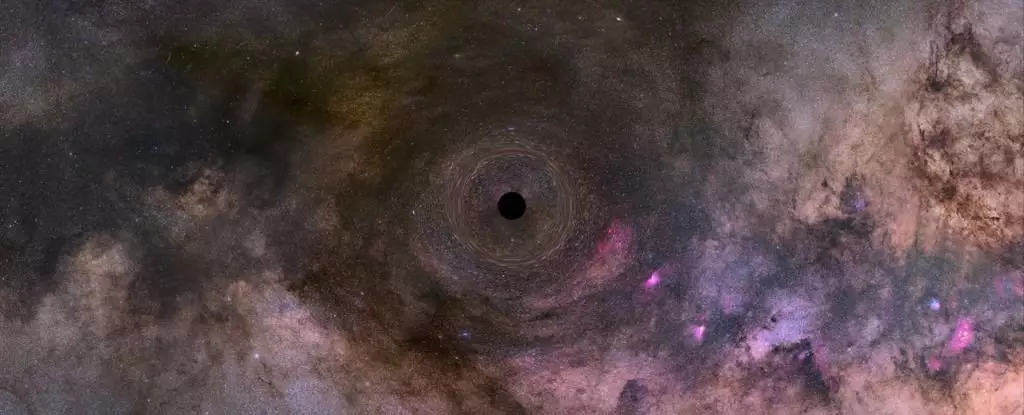The cosmos, in all its grandeur and complexity, continues to confound even the most seasoned astronomers. Recent observations have unearthed a remarkable discovery: a solitary black hole that defies the typical narrative of these enigmatic entities. Unlike their more sociable counterparts which often coexist with stellar binary systems, this black hole is wandering alone in the vastness of space. Located approximately 4,958 light-years from Earth, it possesses a mass equivalent to 7.15 times that of our Sun and is zipping through the universe at a staggering 51 kilometers per second. This singularity has emerged as the first confirmed rogue black hole—a breakthrough that challenges existing astrophysical paradigms and opens new avenues for exploration in the field of celestial objects.
Redefining Our Understanding of Black Holes
Historically, black holes have typically been identified in conjunction with observable companions. In our galaxy, they are unmasked through the gravitational interactions with nearby stars, which reveal their presence through peculiar movements and variations in light. Yet, this newly identified lone black hole relies not on interstellar neighbors but on gravitational microlensing—a phenomenon where the gravitational field of a black hole warps the light from a distant star, creating an illusion of amplification. The identification process was not seamless; it required intricate observations and data collection from multiple telescopes, including advanced monitoring from the Hubble Space Telescope.
The analysis process certainly highlights the sophistication of modern astrophysics. Over a span of 11 years, scientists meticulously gathered and sifted through observational data, culminating in a convincing identification of the rogue black hole. This rigorous methodology emphasizes the importance of collaboration across various observational campaigns, aligning different data sets to reach a consensus. The triumph of pinpointing a solitary black hole, however, is marred by a convoluted path riddled with conflicting conclusions, demonstrating the inherent complexities of cosmic investigations.
A Cosmic Detective Story
The journey towards confirming the identity of this black hole resembles that of a detective unveiling a mystery; it involved initial sightings, misinterpretations, and ultimately, a painstaking refinement of data. The object first garnered attention in 2011 through two pivotal surveys, the Optical Gravitational Lensing Experiment (OGLE) and Microlensing Observations in Astrophysics (MOA). Initial evaluations positioned the density and gravitational impact of the object as suggestive of either a black hole or a neutron star—an ambiguous classification that lingered in scientific discussions for years.
Despite speculations suggesting a neutron star as a plausible alternative, subsequent examinations reaffirmed the black hole status through improved data consistency and more advanced analytical techniques. The continuous exploration underscores the dynamics of scientific inquiry—how initial conclusions can morph as new information emerges, leading to shifts in understanding. This meticulous scrutiny not only affirms the current cosmic identity of the object but also reinforces the fundamental and often changing nature of scientific knowledge.
The Broader Implications of Rogue Black Holes
While this black hole is notable for its solitude, it serves as a significant marker for broader cosmic phenomena. The existence of rogue black holes could suggest a much larger, unseen population lurking in the dark expanses of the universe. The implications are profound—if indeed the universe is teeming with these elusive entities, it invites further inquiry into the life cycles of stars and the gravitational interactions that characterize our cosmic tapestry. This solitary black hole challenges scientists to rethink their models of cosmic evolution and the environments in which such solitary entities may emerge.
Understanding this lone wanderer pushes the boundaries of our astronomical capabilities and compels researchers to refine their tools and methodologies. While the solitary nature of this black hole is compelling, it also raises pressing questions regarding the formation, growth, and ultimate fate of black holes in isolation. The duality of being both a verifiable entity yet still enshrouded in mystery ignites a passion for discovery—a reminder of the wonders that lie in the unexplored depths of the universe.
Through it all, the tale of this rogue black hole exemplifies the exciting yet painstaking nature of cosmic discovery and the relentless human pursuit to decipher the enigmas of our universe. As observations deepen, the universe exposes more of its secrets, offering glimpses into the fabric of existence itself.


Leave a Reply